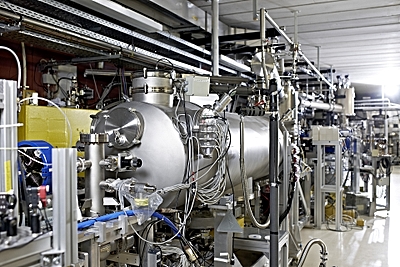HZDR researcher develops new material for particle accelerator
Jana Schaber from the Helmholtz-Zentrum Dresden-Rossendorf (HZDR) has researched a novel photocathode that could make the ELBE high-power radiation source even more powerful, energy-efficient and sustainable. She discovered that the components are easy to produce in the laboratory, but that typical impurities in the material still reduce the quality of the photocathode. As she also decoded the underlying process, the path is now cleared for further improvements so that in the future all particle accelerators could benefit from the advantages.

The heart of ELBE (Center for High Power Radiation Sources at HZDR) is the electron accelerator, which generates an electron beam of the highest brilliance. Source: HZDR/Jürgen Jeibmann
The photocathode is the heart of the HZDR's ELBE particle accelerator. ELBE stands for: "Electron Linear Accelerator for Beams of High Brilliance and Low Emittance". In order to produce an electron beam at the facility, a laser shoots ultraviolet light at a component barely the size of a thumbnail. The energy wrests some of the electrons from the atoms, and the electrons, due to an extremely thin layer of cesium, escape the cathode and become part of the electron beam.
The electron beam from the ELBE particle accelerator produces in turn other radiation: for example, in the infrared, gamma or terahertz range – radiation that draws researchers with their experiments from all corners of the world to Dresden and its ELBE Center for High-Power Radiation Sources. This is because it can be used not only to analyze biological and medical issues, but also to advance physics, materials research and data transfer technology.
To date, photocathodes normally consist of a copper substrate on which researchers grow a layer of cesium crystals in a labor-intensive process. "I went in a different direction and coated a commercially available gallium nitride wafer with an ultra-thin layer of cesium," says Jana Schaber, who studied the photocathode for her dissertation. "These wafers are standard in microelectronics. They are manufactured on an industrial scale and delivered on request in the required size." This brings economic advantages on the one hand, but on the other, this new material combination is capable of even more.
More Efficient and More Sustainable
"Our photocathodes so far have had a quantum efficiency of approximately five percent," the chemist explains. This means that out of one hundred light particles from the laser, only five ultimately manage to knock an electron out of the material. "With the novel cathode made of gallium nitride, however, we're at approximately ten percent. This means we're now about twice as efficient."
In terms of sustainability, her approach also points in the right direction. That is because photocathodes are consumables. The longer they are used, the fewer electrons can be coaxed out of them. At some point they are depleted and must be replaced. Previously they were disposed of. "If, on the other hand, the cathode made of gallium nitride dies, we can simply refurbish it again," stresses Schaber. "To do so, we clean it thermally and then simply deposit a new layer of cesium on it. And then it is ready to reach high quantum efficiencies again."
The innovative material could also solve another problem, the chemist states: "Many researchers who come to us and conduct experiments at the ELBE want higher brilliance. So, this means more electrons per pulse. This is something we can achieve with the gallium nitride photocathodes. The ease of production and the reusability then make them even more sustainable."
Some work, however, is still needed before the novel photocathode can become the standard at the ELBE accelerator. This is because Schaber encountered a limiting factor during her research. "The industrial gallium nitride is almost always contaminated with carbon to a very small degree. During operation, this forms a compound with the cesium over time. It destroys the coating and therefore the cathode." She is now on the hunt for companies that use alternative manufacturing methods for her source material. This is because she is convinced that wafers without carbon impurities could increase the quantum efficiency even further and also increase the lifetime of the photocathode.
In principle, all particle accelerators could benefit from the Rossendorf discovery – regardless of the type of accelerator involved. “We are also working to make the novel material usable for superconducting electron sources." She is referring to the superconducting radio frequency electron source (SRF Gun), introduced at the ELBE in 2014, which produces electrons using conventional technology and accelerates them through a superconducting radio frequency field. "The application as an electron source in such an SRF Gun has never been tested for gallium nitride before," says Schaber. "But I'm confident that it will also work well."
Publication:
J. Schaber, R. Xiang, J. Teichert, A. Arnold, P. Murcek, P. Zwartek, A. Ryzhov, S. Ma, S. Gatzmaga, P. Michel: Influence of surface carbon on the performance of cesiated p-GaN photocathodes with high quantum efficiency, Scientific Reports, 2023 (DOI: 10.1038/s41598-023-30329-0)


